|
|
|
Sort Order |
|
|
|
Items / Page
|
|
|
|
|
|
|
| Srl | Item |
| 1 |
ID:
116127
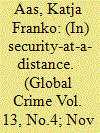

|
|
|
|
|
| Publication |
2012.
|
| Summary/Abstract |
The article examines the progressive de-bounding of social risks and the blurring boundaries between internal and external notions of security. Contemporary forms of cross-border connectivity bring to our attention the renewed importance of analysing distance (physical, social and other) in criminology. Globalising processes significantly expand the scale and scope of social interaction, including violent conflict and crime control and security strategies, by offering social agents a possibility of acting from the point of 'strategic globality'. The article outlines an emerging landscape of 'security at a distance', where previously local and national phenomena are transformed by new forms of transnational connectivity, risk and movement. It suggests that, through the emerging forms of globalism, criminal justice is plugging into trans-border circuits of circulation of people, forms of knowledge and social and political action, where, ultimately, crime control can become an export and war can be, metaphorically, seen as an import.
|
|
|
|
|
|
|
|
|
|
|
|
|
|
|
|
| 2 |
ID:
187832
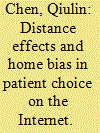

|
|
|
|
|
| Summary/Abstract |
Telemedicine and telehealth hold promise for reducing access barriers caused by travel distance. However, little is known about how the Internet affects patients' online provider choices and thus the spatial distribution of healthcare utilization. This study investigates the effect of distance on flows of online medical consultations using a unique dataset from one of the leading third-party online healthcare platforms in China: Haodf.com. We show that the geographic distance between doctors and patients is negatively associated with online service utilization, though this effect is almost 40% ~ 50% weaker for online medical services than it is for offline medical services. We also find a strong “home bias” in which patients and doctors tend to locate in the same prefecture and in the same province. Further analyses suggest that prior in-person visits before online consultations, the potential need for a follow-up physical visit after an online consultation, and information friction may contribute to the distance effect. These findings have policy implications for improving healthcare access in China and other nations.
|
|
|
|
|
|
|
|
|
|
|
|
|
|
|
|
| 3 |
ID:
185354
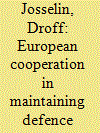

|
|
|
|
|
| Summary/Abstract |
Based on economic geography concepts, this article proposes an original analytical framework to understand co-operation between countries in the Maintenance in Operational Condition (MOC) of defence equipment in Europe. European countries are facing problems of MOC cost growth under strong budgetary and usage constraints. A possible solution is to share costs to benefit from economies of scale. However, as the number of participating countries increases, the “distances” (geographical, normative, political) multiply and generate new costs. These costs are likely to weigh on the choices made by countries and therefore constitute a brake on pooling and sharing initiatives. This article proposes to understand the mutualisation of MOC in Europe through a set of centripetal forces (all the advantages offered by mutualisation) and centrifugal forces (all the costs generated by mutualisation). Such a reading grid makes it possible to consider the multidimensional trade-offs underlying the organisation of MOC in Europe.
|
|
|
|
|
|
|
|
|
|
|
|
|
|
|
|
| 4 |
ID:
125679
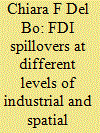

|
|
|
|
|
| Publication |
2013.
|
| Summary/Abstract |
The European electricity sector has undergone significant reforms in recent years, in the direction of market opening, integration and privatization. National and regional markets are now characterized by the presence of domestic and foreign firms, both privately and publicly owned. Did foreign entry induce positive productivity spillovers to domestic firms in the electricity sector, both at the aggregate and disaggregated level, while also controlling for domestic firms' ownership? This paper examines this issue by focusing on regional foreign direct investment (FDI) spillovers in the aggregated electricity sector and in the disaggregated sub-sectors of generation and distribution. The results show the importance of industry aggregation in determining the existence and sign of regional FDI spillovers for domestic firms. FDI spillovers are then calculated based on a purely geographic scale, by considering the distance between each firm's city of location and firms in neighboring cities. The importance and sign of FDI spillovers is different with respect to the analysis based on regional administrative boundaries, suggesting that spatial aggregation, along with industrial aggregation, is relevant in accounting for productivity spillover effects of foreign presence in the EU electricity sector.
|
|
|
|
|
|
|
|
|
|
|
|
|
|
|
|
| 5 |
ID:
175349
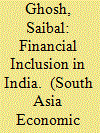

|
|
|
|
|
| Summary/Abstract |
Employing a novel district-level survey data for India, the study investigates the impact of distance on financial inclusion. Using advanced econometric techniques, the findings indicate that distance primarily dampens the use of bank accounts as compared with access. These results are robust irrespective of whether distance is measured in terms of the time taken to reach the banking infrastructure or physical distance. These results are robust to a wide battery of robustness checks. The analysis suggests the need for policy strategies that can address the tyranny of distance towards achieving the financial inclusion goal.
|
|
|
|
|
|
|
|
|
|
|
|
|
|
|
|
| 6 |
ID:
181468
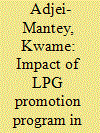

|
|
|
|
|
| Summary/Abstract |
This study investigates the impact of a clean cooking intervention on primary fuel choice and on households’ willingness to pay for an improved LPG distribution model in Ghana. Using data obtained via a survey of 904 households in two beneficiary districts, we found that the intervention led to higher LPG usage. The program increases the probability of households choosing LPG as a primary cooking fuel by 24% and the rate of use of LPG among households by 33%. Furthermore, an analysis of willingness to pay shows that delivery preference is not statistically different between beneficiary and control groups. The distance to refill the cylinder significantly affects LPG usage and willingness to pay. A policy that brings LPG refill closer to households and reduces the time and money cost of accessing a refill station is key to increasing the adoption of LPG as the primary cooking fuel.
|
|
|
|
|
|
|
|
|
|
|
|
|
|
|
|
| 7 |
ID:
158507


|
|
|
|
|
| Summary/Abstract |
They came just after dark,” American war correspondent Ernie Pyle wrote from London in December 1940, about a German bombing raid. “Somehow I could sense from the quick, bitter firing of the guns that there was to be no monkey business this night.” From a balcony, he watched “a night when London was ringed and stabbed with fire.” With dark buildings illuminated by the glow of hundreds of fires, balloons visible against pink clouds, a star peeking between them, it was “the most hateful, most beautiful single scene I have ever known.” Pyle thought of the day when he would be able “to tell somebody who has never seen it how London looked on a certain night in the holiday season of the year 1940.”
|
|
|
|
|
|
|
|
|
|
|
|
|
|
|
|
|
|
|
|
|